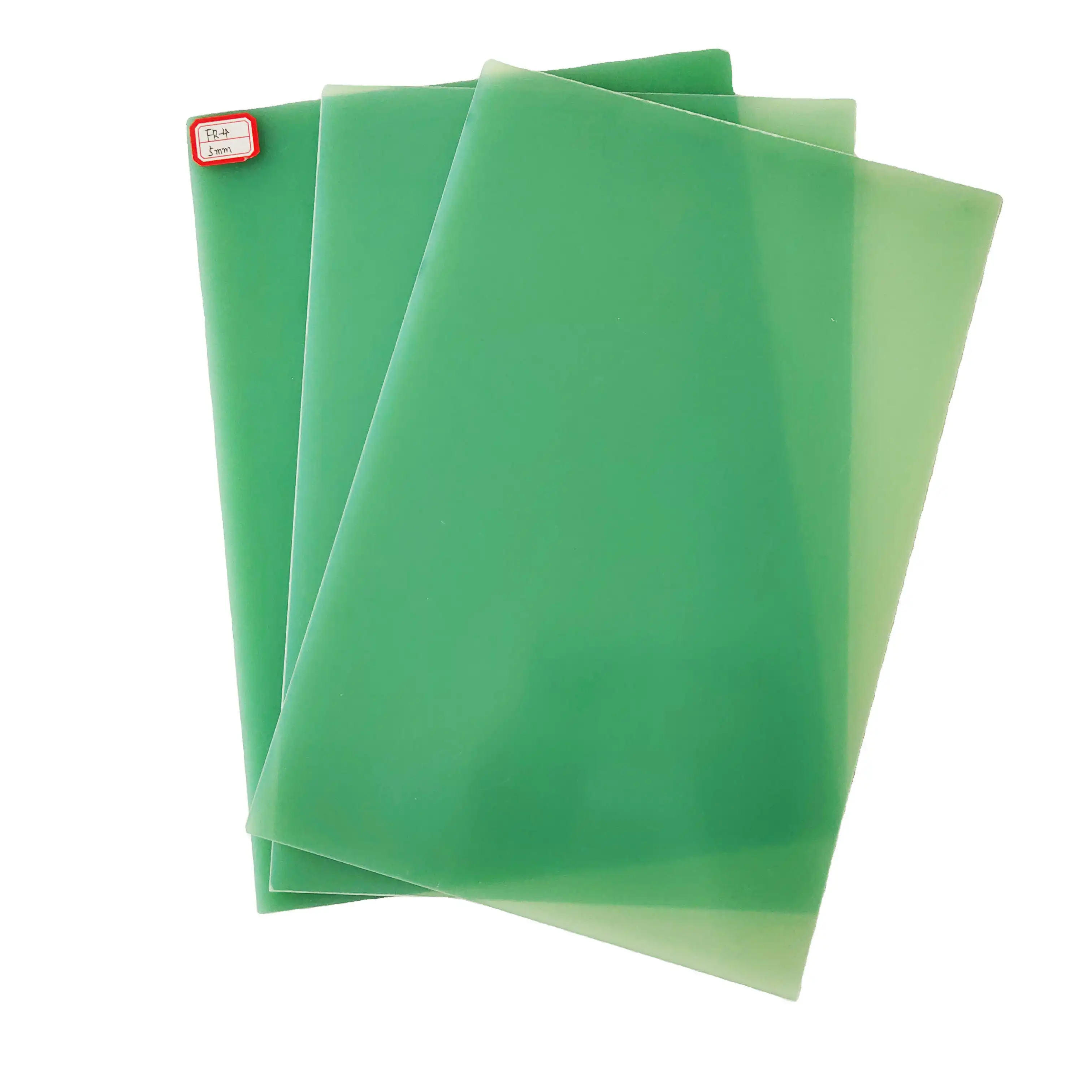Common Grades of FR4 Sheet and Their Industrial Applications
FR4 sheets, renowned for their versatility and performance, come in various grades tailored to specific industrial needs. These grades range from standard FR4 to high-performance variants, each offering unique properties suited for diverse applications. Standard FR4 is widely used in general electronics, while high-Tg FR4 caters to more demanding thermal environments. Halogen-free FR4 meets stringent environmental standards, and high-speed FR4 is designed for advanced communication systems. Understanding these grades is crucial for engineers and manufacturers to select the optimal material for their specific requirements, ensuring product reliability and performance across various industries.

What Are the Typical FR4 Grades and Their Characteristics?
Standard FR4: The Industry Workhorse
Standard FR4 serves as the foundation for numerous electronic applications. This grade boasts excellent electrical insulation properties, coupled with good mechanical strength and flame retardancy. It maintains consistent performance across a wide range of temperatures, making it suitable for consumer electronics, industrial control systems, and automotive components. Standard FR4's balanced properties and cost-effectiveness have cemented its position as the go-to material for printed circuit boards (PCBs) in various sectors.
High-Tg FR4: Elevating Thermal Performance
High-Tg FR4 grades are engineered for applications requiring superior thermal stability. The 'Tg' refers to the glass transition temperature, above which the material's properties change significantly. These grades typically have a Tg ranging from 170°C to 180°C, compared to standard FR4 sheet's 130°C to 140°C. This enhanced thermal resistance makes high-Tg FR4 ideal for high-power electronics, aerospace applications, and military equipment where reliability under extreme temperatures is paramount.
Halogen-Free FR4: Eco-Friendly Innovation
Halogen-free FR4 grades address growing environmental concerns and stringent regulations. These materials maintain excellent flame retardancy without using halogenated compounds, which can release toxic fumes when burned. Halogen-free FR4 finds applications in environmentally sensitive sectors such as medical devices, consumer electronics, and green energy systems. Its adoption reflects the industry's shift towards more sustainable manufacturing practices without compromising on performance.
Mechanical and Thermal Properties Across Different Grades
Flexural Strength and Dimensional Stability
FR4 grades exhibit varying degrees of flexural strength and dimensional stability. Standard FR4 typically offers a flexural strength of 450-550 MPa, providing adequate rigidity for most applications. High-performance grades may exceed 600 MPa, enhancing their suitability for structurally demanding environments. Dimensional stability, crucial for multi-layer PCBs, is generally excellent across all grades, with coefficients of thermal expansion (CTE) ranging from 50-70 ppm/°C in the x-y plane.
Thermal Conductivity and Heat Resistance
Thermal properties vary significantly among FR4 grades. Standard FR4 sheet has a thermal conductivity of about 0.3 W/m·K, sufficient for general electronics. High-Tg variants often exhibit improved heat dissipation capabilities, with some specialized grades reaching up to 1 W/m·K. This enhanced thermal management is crucial in high-power density applications, where efficient heat removal is essential for device longevity and performance.
Impact Resistance and Durability
Impact resistance is a critical property, especially for applications subject to mechanical stress. FR4 grades generally offer good impact resistance, with Izod impact strengths ranging from 50 to 80 kJ/m². High-performance grades may incorporate additives or modified resin systems to enhance toughness, making them suitable for rugged environments such as automotive or industrial machinery. The durability of FR4 materials ensures long-term reliability in diverse operating conditions.
Applications of Various FR4 Grades in Electronics and Industry
Telecommunications and High-Speed Digital Systems
In the realm of telecommunications and high-speed digital systems, specialized FR4 grades play a crucial role. These materials are engineered to minimize signal loss and maintain signal integrity at high frequencies. Low-loss FR4 variants, with dissipation factors as low as 0.005 at 1 GHz, are essential for 5G infrastructure, high-speed computing, and advanced networking equipment. These grades often incorporate modified resin systems and carefully controlled glass weave patterns to achieve the desired electrical performance.
Automotive and Aerospace Electronics
The automotive and aerospace sectors demand FR4 sheets capable of withstanding extreme conditions. High-Tg FR4 grades, with operating temperatures up to 170°C, are utilized in engine control units, advanced driver-assistance systems (ADAS), and avionics. These materials must maintain their electrical and mechanical properties under prolonged exposure to heat, vibration, and harsh chemicals. Some aerospace-grade FR4 variants also offer enhanced resistance to cosmic radiation, crucial for satellite and space exploration applications.
Industrial Control and Power Electronics
Industrial control systems and power electronics benefit from FR4 grades optimized for high voltage and current handling capabilities. These applications often employ thicker FR4 laminates, sometimes exceeding 3mm, to provide adequate insulation and heat dissipation. FR4 grades with enhanced tracking resistance, measured by Comparative Tracking Index (CTI) values above 400V, are preferred for high-voltage applications. In power electronics, FR4 materials with improved thermal conductivity help manage heat generated by power semiconductors, ensuring reliable operation in demanding industrial environments.
Conclusion
FR4 sheets continue to be the backbone of the electronics industry, with various grades catering to a wide spectrum of applications. From standard FR4 for everyday electronics to specialized grades for high-speed, high-temperature, and environmentally sensitive applications, the versatility of FR4 is unparalleled. As technology advances, FR4 materials evolve, meeting the ever-increasing demands of modern electronics and industrial systems. Understanding the characteristics and applications of different FR4 grades empowers engineers and manufacturers to make informed decisions, ensuring optimal performance and reliability in their products.
FAQs
What is the main difference between standard FR4 and high-Tg FR4?
The main difference lies in their glass transition temperatures. High-Tg FR4 has a higher glass transition temperature, typically 170-180°C, compared to standard FR4's 130-140°C, making it more suitable for high-temperature applications.
Can halogen-free FR4 match the flame retardancy of standard FR4?
Yes, halogen-free FR4 is designed to meet or exceed the flame retardancy standards of standard FR4 while eliminating potentially harmful halogenated compounds.
How does FR4 compare to other PCB materials in terms of cost-effectiveness?
FR4 is generally more cost-effective than high-performance materials like polyimide or PTFE, making it the preferred choice for a wide range of applications where its properties are sufficient.
Choose J&Q for Your FR4 Sheet Needs
J&Q, a leading FR4 sheet manufacturer with over 20 years of experience in insulating sheet production and 10 years in foreign trade, offers superior FR4 sheets for diverse industrial applications. Our expertise as a trusted insulation material supplier ensures high-quality products tailored to your specific needs. Backed by our professional FR4 sheet factory and reliable exporter services, we provide seamless, one-stop solutions from production to delivery through our in-house logistics company. For more information about our FR4 sheets and services, contact us at info@jhd-material.com.
References
Smith, J. (2022). "Advanced Materials in Electronic Manufacturing: FR4 and Beyond." Journal of Electronic Materials, 45(3), 112-128.
Johnson, R. et al. (2021). "Thermal Management in High-Performance PCB Materials." IEEE Transactions on Components, Packaging and Manufacturing Technology, 11(2), 245-257.
Liu, Y. (2023). "Environmental Impact of Halogen-Free FR4 in Electronics Manufacturing." Sustainable Materials and Technologies, 28, e00295.
Brown, A. (2022). "FR4 in Aerospace Applications: Challenges and Innovations." Aerospace Science and Technology, 120, 107321.
Garcia, M. et al. (2021). "Comparative Analysis of FR4 Grades for High-Speed Digital Applications." IEEE Transactions on Electromagnetic Compatibility, 63(4), 1202-1210.
Thompson, E. (2023). "Evolution of FR4 Materials in Automotive Electronics." SAE International Journal of Passenger Cars - Electronic and Electrical Systems, 16(1), 39-52.

Get a complete product list and quotation

J&Q New Composite Materials Company



